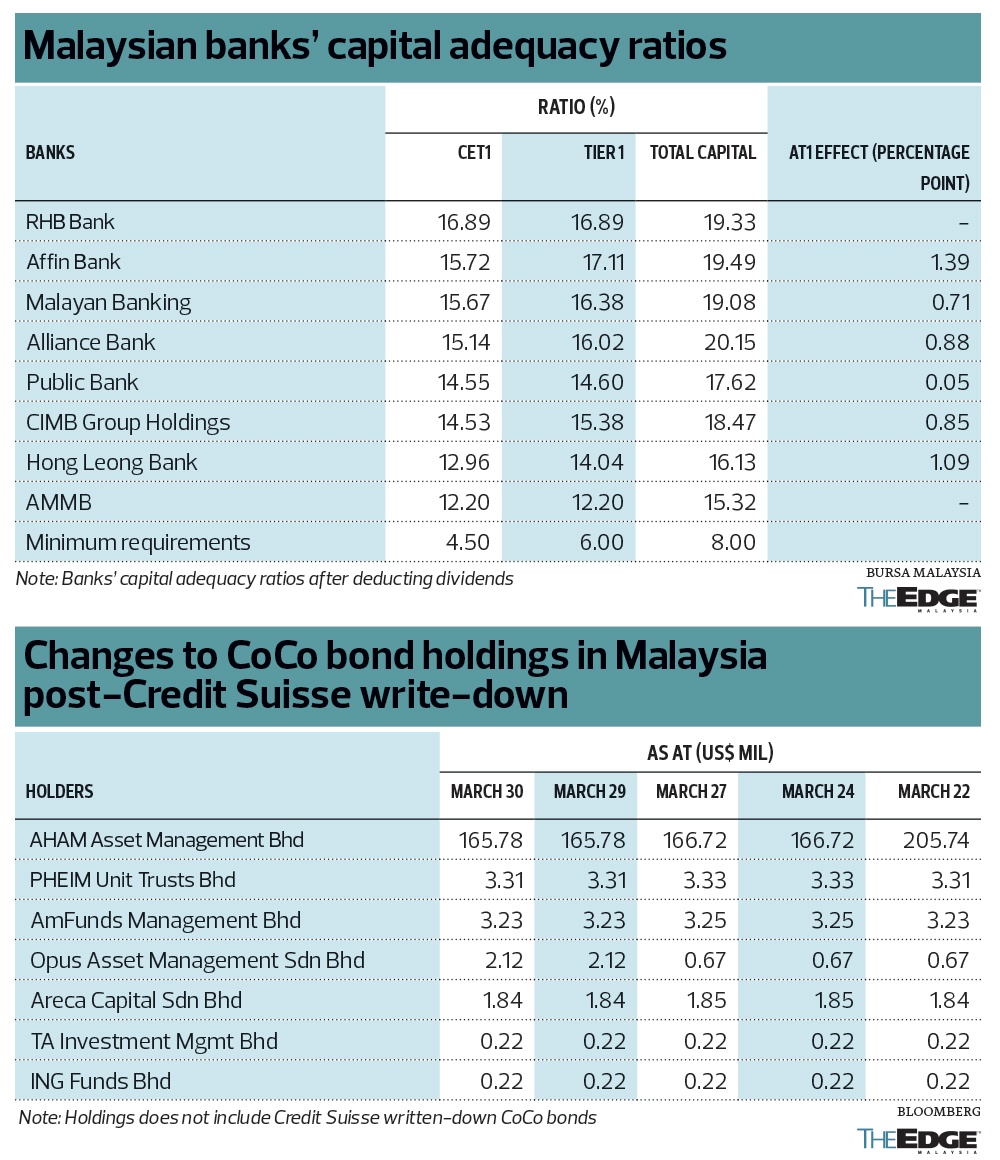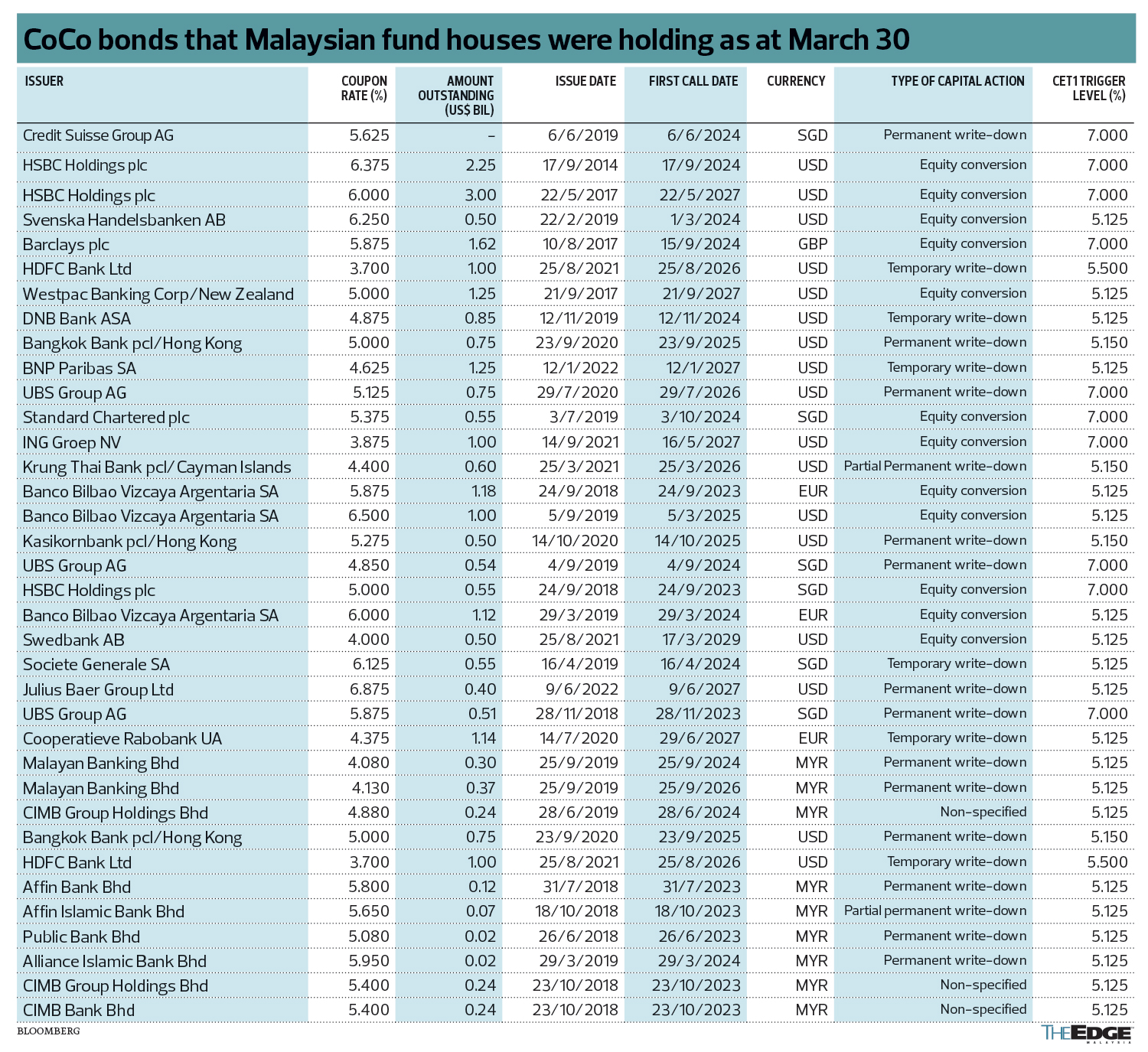
This article first appeared in The Edge Malaysia Weekly on April 3, 2023 - April 9, 2023
PRIOR to the Swiss government’s decision on the UBS Group AG-Credit Suisse Group AG merger, which led to the write-down of the latter’s CHF16 billion (RM77 billion) Additional Tier 1 (AT1) capital, or contingent convertible (CoCo) bonds, not many in Malaysia would have heard of these hybrid securities that have the characteristics of both debt and equity.
CoCo bonds are typically issued by financial institutions to raise capital and are designed to be converted into equity or written off in the event of a specified trigger event, such as a significant decline in the bank’s capital ratios.
In Malaysia, these financial instruments came into the spotlight after AHAM Asset Management Bhd suspended dealings in the units of two bond funds that had invested primarily in Credit Suisse’s CoCo bonds. AHAM was quick to clarify that the collective fund size of the AHAM Single Bond Series 2 and AHAM Single Bond Series 4 represented less than 0.1% of its RM77 billion in assets under management (as at Feb 28).
In response to The Edge’s queries, the Securities Commission Malaysia says “it does not see this development related to AT1 bonds posing any systemic risk to the Malaysian market”, noting that the local portfolio exposure to Credit Suisse’s AT1 bonds “are those two wholesale funds”, which account for less than 0.1% of the firm’s total assets under management.
“Based on our review and assessment, the overall exposure to Credit Suisse’s AT1 bonds in the Malaysian fund management industry is not substantial and is contained. We will continue to closely monitor the situation from a global and local level,” says the SC.
Malaysian banking institutions do not rely heavily on CoCo bonds to strengthen their capital position, says Bank Negara Malaysia governor Tan Sri Nor Shamsiah Mohd Yunus, pointing out that more than 80% of local banks’ capital components are made up of common equity and retained earnings.
Local banks’ filings with Bursa Malaysia show that AT1 capital makes up between 0.05 and 1.39 percentage points of their Tier 1 capital ratio. More importantly, local banks’ Common Equity Tier 1 capital (CET1) ratio ranges between 12.20% and 16.89%, which is already well above the minimum requirement of 4.5%. Tier 1 capital consists of CET1 and AT1.
According to Bloomberg data as at March 30, outstanding CoCo bonds issued by Malaysian banks amounted to RM10.5 billion, with issuers including Malayan Banking Bhd (Maybank), CIMB Group Holdings Bhd, Public Bank Bhd, Hong Leong Bank Bhd, Affin Bank Bhd and Alliance Bank Malaysia Bhd.
The coupon rates for these perpetual instruments range from 3.6% to 5.95%, with half of them having provisions for permanent write-downs, two with partial write-downs and the remaining seven issued by CIMB Group and CIMB Bank Bhd with non-specified capital action.
RHB Bank Bhd and AMMB Holdings Bhd have no issuances of CoCo bonds. Yet, the former has the highest CET1 ratio among its peers.
No direct exposure
Among the local banks contacted, Maybank and RHB Bank tell The Edge that they have “no direct exposure” to AT1 bonds at this juncture while Hong Leong Bank says it “does not have any exposure to CoCo bonds”.
“Maybank will continue to manage its business prudently, where it has a well-diversified depositor base, maintains a comfortable liquidity coverage ratio (LCR) and robustly manages its investment portfolio and liquidity. While there is volatility influencing the banking industry globally, we are committed to staying the course on our M25+ Strategy in the medium term,” Maybank says in an email.
Angus Salim Amran, group treasurer at RHB Banking Group, assures the public that the group does not have any exposure to CoCo bonds. “While being a permitted investment instrument, we have opted for a more conservative investment strategy by moving up the credit curve in response to elevated financial risk,” he says in an email reply.
Similarly, Hong Leong Bank tells The Edge that it has no exposure to CoCo bonds at all. “Internally, we have a prudent investment policy in place, whereby we will only invest in credits/bonds that meet our specific criteria.”
Funds have minimal CoCo holdings
When it comes to CoCo bond holdings, SC chairman Datuk Seri Dr Awang Adek Hussin revealed that Malaysian fund houses hold about RM4 billion worth of these financial instruments.
“We are looking at the situation very closely and talking to some players in the market. But one thing for sure is that we do not have to worry about any systemic risks,” he told a press conference last week after the release of the SC’s latest annual report.
He added that the CoCo bond holdings were deemed small compared to the local fund houses’ more than RM900 billion in assets under management.
Unlike in Singapore, where both banks and asset management houses have exposure to CoCo bonds, our screening of Bloomberg data shows that only a few fund houses in Malaysia have exposure to these financial instruments, holding a total of US$176.72 million (RM780.6 million) as at March 30.
Regulations on AT1 capital
Nor Shamsiah recently made it clear that even in the event of distress, CoCo bonds have seniority over common equity, citing the Financial Stability Board’s (FSB) Key Attributes of Effective Resolution Regimes for Financial Institutions.
According to Key Attribute 5.1, resolution powers held by agencies such as Bank Negara and Perbadanan Insurans Deposit Malaysia (PIDM) should be exercised in a way that respects the hierarchy of claims.
If necessary, these authorities should be given flexibility to depart from the general principle of equal treatment of creditors of the same class, with transparency over the reasons for such departures to contain the potential systemic impact of a firm’s failure or to maximise the value for the benefit of all creditors as a whole.
“In particular, equity should absorb losses first, and no loss should be imposed on senior debt holders until subordinated debt (including all regulatory capital instruments) has been written off entirely (whether or not that loss absorption through write-down is accompanied by conversion to equity),” the document reads.
Nonetheless, it is worth noting that according to Bank Negara’s Capital Adequacy Framework (Capital Components) published in December 2020, AT1 capital instruments should meet certain criteria, including that it is subordinate to depositors, general creditors and other holders of subordinated debt of the financial institution.
“The instrument is neither secured nor covered by a guarantee of the financial institution or an affiliated entity or other arrangement that legally or economically enhances the seniority of the claim vis-à-vis depositors, general creditors and other holders of subordinated debt of the financial institution,” the framework reads.
Meanwhile, there should be provisions governing AT1, requiring the instrument to be written off or converted into ordinary shares if the CET1 capital ratio drops below 5.125% in order to boost a financial institution’s capital back to at least 5.75%. “If this is not possible, then the full principal value of the instrument must be written off or converted into ordinary shares,” it adds.
Strong capital buffers
According to a credit risk management executive at a local bank, the central bank does not have a specific limit to how much AT1 capital a local bank can hold, so long as it has set aside sufficient capital buffers that commensurates the risks of the instruments it holds.
In Bank Negara’s Capital Adequacy Framework (Basel II — Risk-Weighted Assets) on calculation of minimum capital requirement, the central bank states that it “does not intend to prescribe the form or operational details of banking institutions’ risk management policies and practices, but will exercise its right to perform detailed review procedures to ensure that systems and controls are adequate to serve as the basis for the IRB (Internal Ratings Based) approach”.
Asked to comment on the Credit Suisse development, Bank Negara says Malaysia’s financial institutions “have limited exposure to Credit Suisse” and affirmed that the country’s financial markets “continue to function effectively with ample liquidity”.
“Malaysia’s banking system remains well capitalised and has strong liquidity buffers to support financial intermediation. Bank Negara will continue to closely monitor developments [as well as] the domestic financial system to ensure its orderly function,” it adds.
Bank Negara had said earlier that the Malaysian banking system has no direct exposure to the collapse of Silicon Valley Bank and two other US banks.
“Any indirect exposure — be it from counterparties or borrowers with linkages to the US banks — is also very limited. All licensed banks in Malaysia, domestic or foreign-owned, large or small, must comply with the stringent capital and liquidity rules on an ongoing basis. These rules are designed to ensure banks can withstand stress conditions,” the central bank says, adding that details of these stress tests are published in the Financial Stability Review twice a year.
“Further, regular stress tests conducted by Bank Negara and the banks continue to affirm that banks can withstand severe macroeconomic and financial shocks and remain well positioned to support lending to businesses and households under various adverse events.”
The strength of the local banking system was also emphasised by Manulife Investment Management in a March 22 note to clients that was shared with the media. In the note, it says potential contagion to Asian banks emanating from this episode “seems limited as they are well capitalised and direct exposures are small in scale”.
In addition, LCRs are high and deposit bases tend to be stickier, the firm’s co-head of global macro strategy Sue Trinh writes in the note.
“It is also worth noting that corporate deposits are well diversified across industries. In our view, direct contagion from the recent banking scare to Asia is largely limited, to the extent that financial and macro stability positions of economies in the region are generally more robust than previous crises,” she adds.
Save by subscribing to us for your print and/or digital copy.
P/S: The Edge is also available on Apple's App Store and Android's Google Play.
- SumiSaujana slumps on ACE Market, on course to be worst IPO debut
- Malaysian stocks broadly lower as Asian investors brace for Trump tariffs
- After strong FY2025, Aeon Credit's earnings upside may be capped, CIMB Securities warns
- HHRG’s largest shareholder goes to court to convene EGM to remove board
- US slaps higher taxes on small parcels in tit-for-tat trade war



